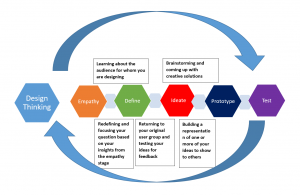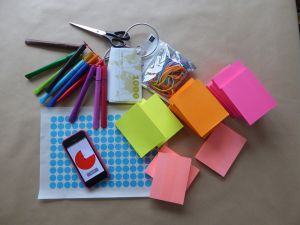Difference between revisions of "Design Thinking"
AlexaBoeckel (talk | contribs) |
AlexaBoeckel (talk | contribs) |
||
| Line 25: | Line 25: | ||
== The Process == | == The Process == | ||
=== Empathise === | === Empathise === | ||
| − | + | In the first phase of the process, you try to change your perspective to the user that you want to focus on. Define your target/ user group and research about their background. You can make use of persona building to visualize your target group. Demographics help you to understand the framework conditions of your user group and have a look at sinus milieus. Your goal is to be able to think and feel like the person or group of persons you want to empathize with.<br> | |
=== Define === | === Define === | ||
| − | + | In the second step, you want to define your problem from the perspective of the user. What are the needs and problems? What are the pain points? Why is the described challenge a problem to the person?<br> | |
| + | |||
=== Ideate === | === Ideate === | ||
| − | + | This is the wild phase to develop ideas for solutions. You can use different methods as brainstorming, brainwriting, a written discussion, who-writes-the-most-ideas-on-post-its with the goal to broaden your view. No idea is too big or too far out of the box, the restrictive thinking comes later. Try to challenge general assumptions.<br> | |
| + | |||
=== Prototype === | === Prototype === | ||
| + | |||
– to start creating solutions<br> | – to start creating solutions<br> | ||
=== Test === | === Test === | ||
Revision as of 11:35, 24 July 2020
Design Thinking are rules for a guided design process to find user-centered solutions in small teams.
What
- guidelines for a creative process in product design with a user-centered perspective
- iterative process of brainstorming, persona building, prototyping and testing
- Disclaimer: Design Thinking does not necessarily helps you to compromise and balance different interests on the same resource.
Why & When
- useful if you want to solve a problem
- helps to understand your target group's position
- prevents you from creating a solution when there is no problem
- one team should not be larger than 5, but you can scale up the amount of teams
- the length of the process is expandable (up to a week), but you can squeeze it into a 3-hour workshop
Goal(s)
Understanding a problem with a certain perspective and create a concept for a solution for it in a small team.
What do you need?
First, you have to decide under which conditions you want to host a design thinking session. What is the topic or the problem you want to work on? Which participants, perspectives and skills do you need to go through the process? It is recommendable to not work in larger groups than five, if you are more participants, you can split up in smaller teams and find out with what kind of solutions you come up with.
Define a workshop facilitator if you do not want to do it on your own and create an agenda. Find a room and organize the material and resources that you need (paper, pen, post-its, whiteboard etc.)
Second, you need to communicate what you expect from the participants: Time, energy, attention. Try to make use that every participant is actually committed as one team member less is easier to work with than somebody dropping in and out.
The Process
Empathise
In the first phase of the process, you try to change your perspective to the user that you want to focus on. Define your target/ user group and research about their background. You can make use of persona building to visualize your target group. Demographics help you to understand the framework conditions of your user group and have a look at sinus milieus. Your goal is to be able to think and feel like the person or group of persons you want to empathize with.
Define
In the second step, you want to define your problem from the perspective of the user. What are the needs and problems? What are the pain points? Why is the described challenge a problem to the person?
Ideate
This is the wild phase to develop ideas for solutions. You can use different methods as brainstorming, brainwriting, a written discussion, who-writes-the-most-ideas-on-post-its with the goal to broaden your view. No idea is too big or too far out of the box, the restrictive thinking comes later. Try to challenge general assumptions.
Prototype
– to start creating solutions
Test
– solutions
Rules
-
yes, and: The rule of "yes-and" means, that you should try to build up on each others ideas. Even though you have the impression that the suggestion by your team member is not suitable, add something that makes it fitting
-
quantity first, quality second OR first storm, then criticise: Not everything that is brought up in the process will be the next big thing. Try to not judge ideas and collect everything at first. You can throw out unnecessary stuff later.
-
keep the target in mind: As it happens fast that you get carried away by the brainstorm-thunder, try to get back to the problem description multiple times and check whether your solution fits to the problem and target group. This helps you to stay on track and adjust if necessary.
-
work as one group: You might have the impression that your idea is better than the other one. Try to focus on one idea with the whole group and do not start to do your own thing. Use the attention of the whole group to progress.
-
be visual: Depending on your preference, you can draw an idea, make a mindmap, write everything on post-its or use a written discuss - the most important aspect is: write it down. Therefore, you will have a written documentation later and can get back to ideas that were brought up hours ago.
Example for sustainability science
Imagine you want to find solutions for different stakeholders on land use in the city of Lüneburg.
- At first, you would need to define the different needs of the stakeholder and cluster them into need groups, e.g. all stakeholders that are interested in climate change mitigation aspects.
- Then, you would assign one team per need group and let them dive into the process. The process steps are still the same for all of the groups.
- After having finished the process, you can compare the different solutions. One group might have come up with a participation format of how to include a group that is not yet involved in a decision process. Another group might have developed a ranking scheme for decision criteria and so on. Now, you can see whether there are similarities between the different solutions and how they can be combined, transferred to another need group.
Links & Further reading
-
https://hpi.de/en/school-of-design-thinking/design-thinking/background/design-thinking-principles.html
- Tips for organizing design thinking sessions: https://newkind.com/12-design-thinking-rules-from-david-burney/
- Conference Paper on Design Thinking Methods: https://link.springer.com/chapter/10.1007/978-3-319-20886-2_2
- Youtube Video about Design Thinking principles (very entrepreneurial): https://www.youtube.com/watch?v=gHGN6hs2gZY

